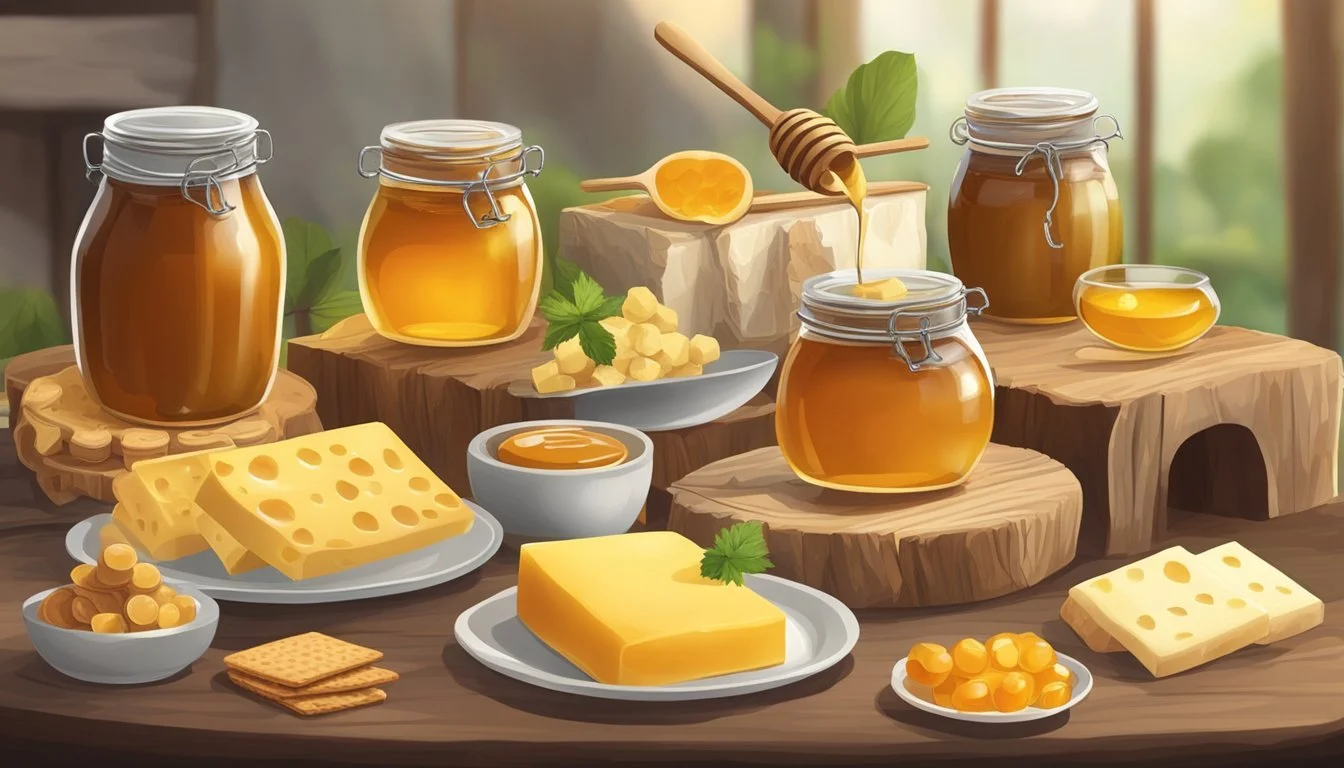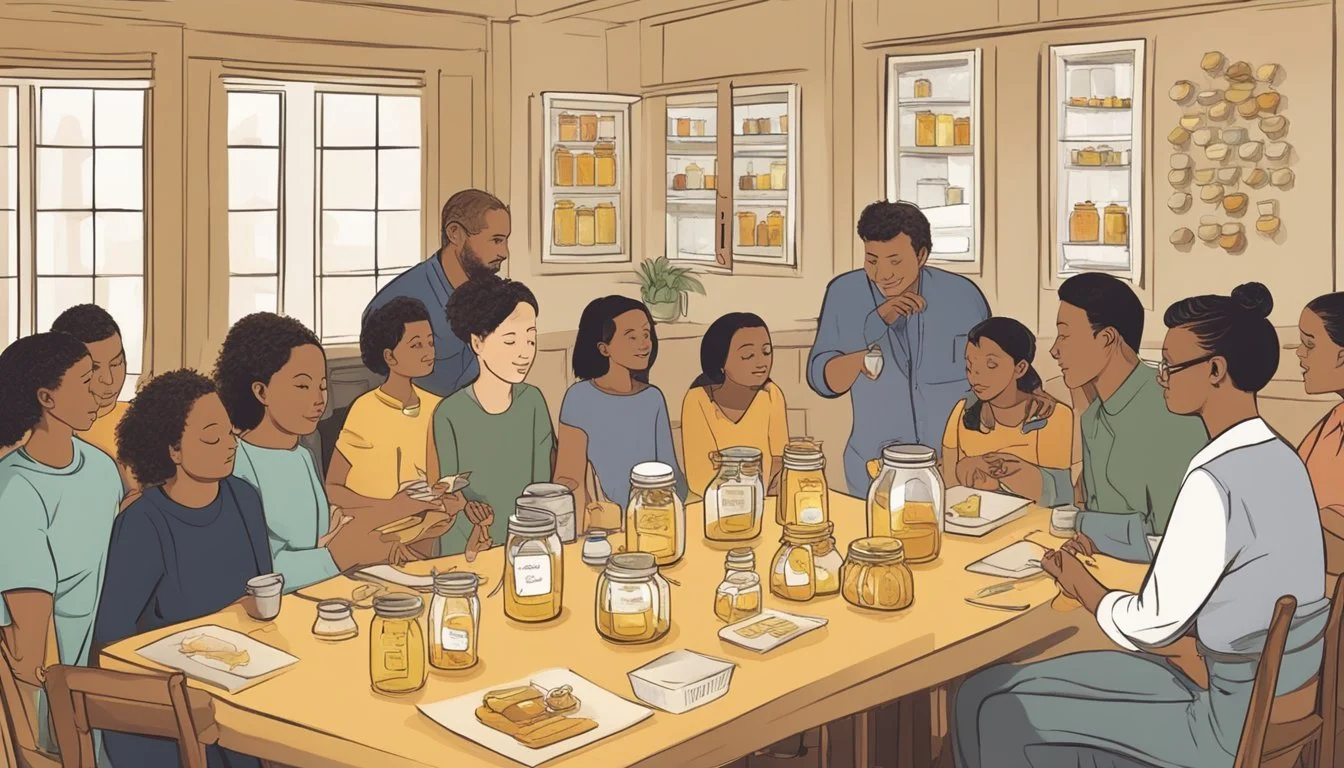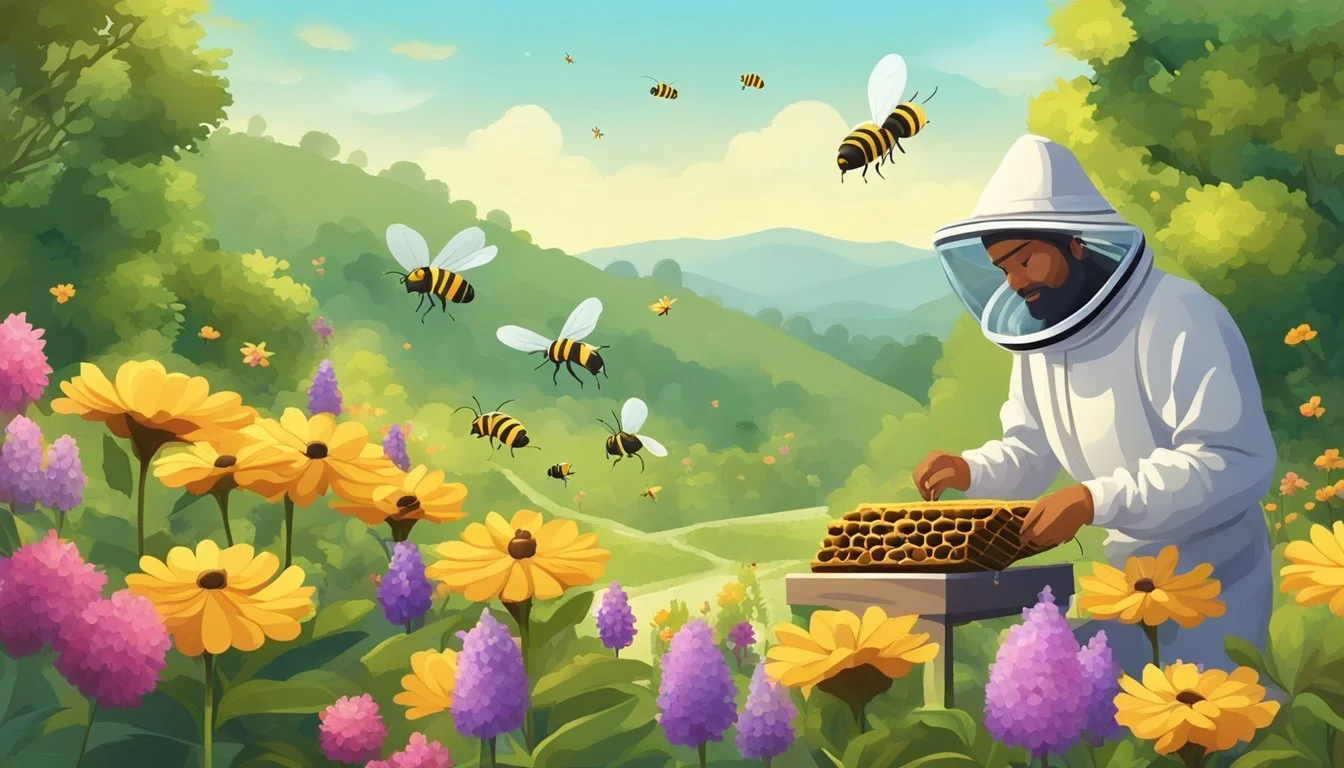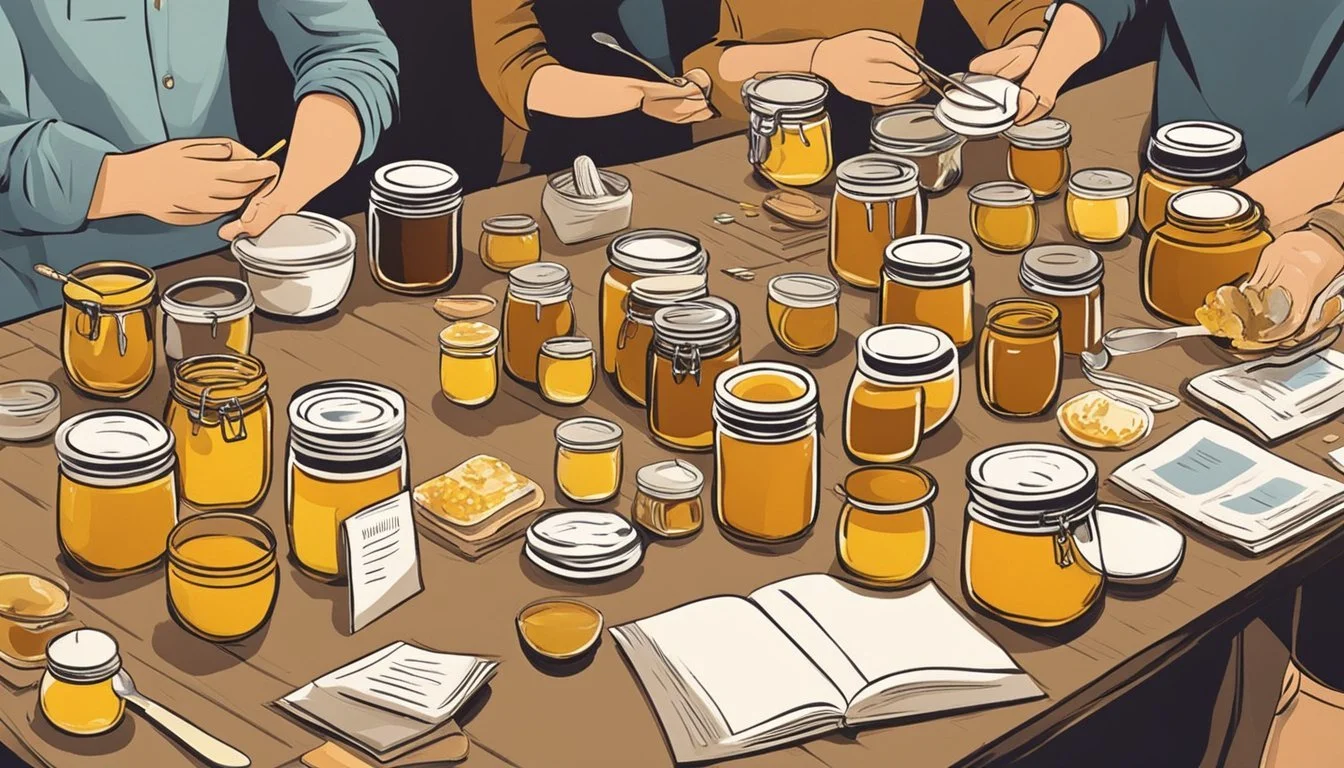Tips for Hosting a Honey-Tasting Party
A Guide to Sweet Success
Hosting a honey-tasting party is an engaging way to explore the nuanced world of honey (What wine goes well with honey?) with friends and fellow enthusiasts. Much like wine tasting, honey tasting allows participants to savor the diverse flavors, aromas, and textures that different honeys have to offer. With over 300 varieties of honey in the United States alone, there's a rich tapestry of tastes to discover, each influenced by the unique flowers and regions from which the bees collect nectar.
Organizing a honey-tasting event requires thoughtful preparation to ensure guests can fully appreciate the subtle differences between each type of honey. Selecting a variety of honeys from floral to herbal notes, from light to dark amber, gives a cross-section of flavors. Complementing the honey with appropriate food pairings and beverages can enhance the experience, highlighting the honey’s characteristics and allowing for pleasant contrasts or complementary flavors that delight the palate.
The key to a successful honey-tasting party lies in its setup. Presenting honeys in a manner that facilitates ease of tasting and comparison, while also educating guests about the origins and profiles of each variety, contributes to an informative and enjoyable experience. Attendees leave not only with a newfound appreciation for honey but also with the knowledge that can transform their culinary uses of this natural sweetener.
Understanding Honey Tasting
Honey tasting provides an opportunity to appreciate the diverse flavors and aromas that different honeys possess. This journey through taste and scent profiles requires a fundamental understanding of honey's unique characteristics and a methodical approach similar to wine tasting to fully experience each variety's nuances.
Fundamentals of Honey Flavors and Aromas
Each type of honey has a distinctive flavor and aroma profile largely influenced by the nectar and pollen sourced by bees. Flavors can range from sweet and floral to earthy and spicy, with an array of aromatic notes to complement them. Visually examining the color of honey provides initial clues to its flavor profile, as darker honeys typically have a bolder taste compared to the light and subtle flavors of paler varieties.
Key Sensory Characteristics to Note:
Flavor: Sweetness, bitterness, richness, and spice levels.
Aroma: Floral, fruity, woody, or grassy scents.
Color: Ranges from clear and pale to dark and amber.
Tasting Notes:
When tasting, one should note the immediate taste on the palate, the body of the honey, and the lingering aftertaste.
Documenting these details helps in creating a comprehensive tasting note for each honey.
Comparing Honey Tasting to Wine Tasting
The ritual of honey tasting shares similarities with wine tasting in the consideration of sensory characteristics. Like wine connoisseurs, honey enthusiasts observe the aroma, color, and flavor in a structured tasting process. They may use a tasting wheel to detail the complex flavor profiles and share tasting notes regarding the nuances in each variety.
Table: Honey Tasting vs. Wine Tasting - Similar Aspects
Aspect Honey Tasting Wine Tasting Aroma Inhale before tasting to detect scent notes. Swirl and sniff to identify aromatic compounds. Flavor Savor the honey, noting the start, mid-palate, and finish. Taste progressively from front to back of tongue. Color Observe color as it hints at taste depth. Inspect color to gauge age and grape type. Characteristics Floral source and region affect flavor profiles. Terroir and vintage impact flavor nuances.
In both practices, the process enhances the experience of tasting by providing a deeper understanding of the product's origins and the factors that shape its sensory characteristics.
Planning Your Honey-Tasting Party
Hosting a honey-tasting party is an excellent opportunity for friends and the community to explore the exquisite world of honey. It’s all about showcasing different varietals and the unique flavors each brings. The success of your party relies on the selection of honey, the ambiance you create, and the preparations for your guests.
Selecting a Diverse Range of Honey Varietals
When choosing honeys, aim for a wide variety from the mild, sweet clover honey to the strong, distinct manuka honey. Consider including:
Raw Honey: Unprocessed and with a rich taste
Local Harvested Honey: Supports local beekeepers and offers a taste of the community’s flora
Unique Varietals: Such as wildflower, which changes with the seasons, providing a unique tasting experience
Here's a suggested honey lineup:
Clover Honey: A common and pleasantly mild choice, perfect for newcomers.
Wildflower Honey: An embodiment of the local flora, varying by season and location.
Manuka Honey: Known for its stronger flavors and potential health benefits.
Local Honey: Showcase regional tastes and support local beekeepers.
Rare Varietals: Introduce honey samples not commonly found in grocery stores to intrigue seasoned tasters.
Creating a Themed Environment
The ambiance of your party can enhance the tasting experience. Decorate with motifs that reflect the environment where various honeys are harvested. For instance, a tablecloth with floral prints can represent wildflower honey, while photos or small potted plants reflective of where manuka honey is sourced can provide context and conversation starters.
Here are a few decoration ideas to consider:
Floral Arrangements: Echo the blooms that bees visit.
Themed Tableware: Serving dishes and utensils that fit the honey and bee theme.
Soft Lighting: Ensure the lighting is not too harsh, to keep the focus on the honey’s color and texture.
Invitation and Guest Preparation
When sending out invitations, include details to set expectations:
Attire: Suggest guests wear something that fits the theme.
What to Bring: Recommend that guests bring empty jars in case there are honey samples to take home.
Provide information on what will occur at the party, such as how the honey will be presented and if there will be educational components about the different honeys. Ensure guests are ready to engage their palates and learn about the diverse world of varietals.
Setting Up for the Party
A well-prepared setting elevates a honey-tasting party, making it an enlightening and enjoyable experience. Attendees will appreciate the attention to detail that allows them to focus on the nuances of each honey variety.
Necessary Tasting Materials and Tools
The host should provide tasting spoons—one per guest per honey type—to ensure a fresh taste for each sample. It's vital to have a selection of spoons or sticks made from neutral materials like wood, which do not impart additional flavors to the honey. In addition, enough tasting plates or boards should be available to display the varieties of honey in a visually appealing way, highlighting their texture and color differences.
Ideal Lighting and Seating Arrangements
Proper lighting is crucial as it allows guests to observe the honey's true color and clarity, influencing their perception of quality and flavor. Natural light is best, but if it's not available, ensure the artificial lighting doesn't alter the honey's appearance. Seating should facilitate easy movement and interaction, with chairs and tables arranged in a way that promotes conversation and easy access to the honey samples.
Cleansing Palates Between Samples
To ensure the results of the tasting are not compromised by lingering flavors, offer guests a variety of palate cleansers. Water is essential; provide still or sparkling to rinse the mouth between honeys. Neutral foods like unsalted crackers or plain bread can also serve to cleanse the palate. These should be placed strategically around the tasting area so guests can help themselves as needed.
Conducting the Honey Tasting
The honey tasting event is the heart of your gathering, where participants engage their senses to explore the complexities of honey. Guiding this experience thoughtfully ensures everyone has a rewarding and educational experience, akin to the expertise a honey connoisseur or honey sommelier would provide.
Guiding the Tasting Experience
To begin, set the stage by ensuring each guest has the necessary utensils: a tasting spoon, a glass of water for palate cleansing, and a honey aroma and tasting wheel. The host introduces each honey variety, highlighting its origin and distinctive qualities. A suggested approach is to start with lighter honey flavors and progress to darker, more robust varieties, allowing the subtleties of each to shine without overpowering the senses.
Documenting Tasting Notes and Impressions
Providing guests with a notepad or a structured tasting sheet encourages them to jot down their observations. They should focus on the color, aroma, flavor, and texture of each honey. Encourage guests to refer to the tasting wheel to articulate their impressions, using terms like "floral," "fruity," or "woody." This documentation enhances engagement and provides a record of their preferences.
Engaging Guests with Honey Knowledge and Facts
As participants savor each sample, share fascinating insights about honey production and its health benefits. Explain the role of nectar sources in flavor profiles and the factors influencing honey's color and consistency. Engaging guests with this educational aspect enriches the experience, fostering appreciation for the intricacies involved in the creation of each honey variety.
Pairing Honey with Food and Beverages
Careful selection of food and beverages that complement the diverse flavors of honey elevates the tasting experience. From creamy cheeses to robust wines, the right pairing can accentuate the unique characteristics of each honey variety.
Cheese and Honey Pairings
Mild & Creamy: Pair a light, floral honey with soft cheeses (What wine goes well with soft cheeses?) like Brie or Camembert to enhance their creaminess without overpowering them.
Bold & Earthy: For a cheese with more earthy tones, like Gorgonzola, choose a dark, amber honey that can stand up to the strong flavors.
Savory & Spicy: Hard cheeses such as aged Cheddar or pepper jack can be balanced with a honey possessing a spicy or caramel note.
Honey and Beverage Combinations
Tea:
Green Tea: Complement with a light, citrus-infused honey to bring out the tea's delicate flavors.
Black Tea: A stronger, nutty honey will enhance the robust qualities of black tea.
Wine:
White Wine (Dry and Full-bodied): A sweet honey like Rocky Mountain pairs well with Chardonnay, offering a taste contrast that balances the palate.
Red Wine: A honey with berry undertones complements the complex notes found in a rich Merlot.
Sweet and Savory Accents
Sweet Accents:
Chocolate: Dark chocolate harmonizes with a rich honey drizzled on top. This creates a decadent treat that melds bittersweet and sweet profiles.
Biscuits and Cookies: Simple biscuits or cookies serve as an excellent canvas for honey, allowing it to be the star flavor.
Crackers: Opt for unsalted or mildly flavored crackers to let the variations of honey shine without competition.
Fruit and Nuts: Pair honey with tart berries or apples to complement its sweetness, and add nuts for a crunchy texture contrast.
Exploring the Source of Honey
Understanding the intricate relationship between bees, nature, and the environment provides valuable insight into the unique characteristics of different types of honey. The following subsections delve into the specifics of honey production and how varying factors contribute to its diverse flavors.
The Role of Bees and Nature in Honey Production
Bees play a crucial role in honey production, drawing nectar from flowering plants like clover, orange blossom, and buckwheat. The local beekeeper facilitates this natural process, often ensuring that bees are healthy and thriving in an environment suited to produce the best possible honey. Honey's color and sweetness stem directly from the nectar bees collect and the intricate processes they employ back at the hive.
Seasonal Variations and Terroir
Terroir—a term traditionally associated with wine—relates to how a region's climate, soils, and aspect affect the taste of agricultural products. Honey is no exception. Seasonal variations, like the harvest period during fall, can lead to the development of rich flavors, yielding varieties such as cinnamon-spiced buckwheat honey or fragrant orange blossom honey. The terroir influences not only the taste but also the texture and sweetness of the final product as bees collect nectar from different plants throughout the seasons.
Going Beyond the Party
After the last spoonful of honey is sampled and guests depart, a host's engagement with the fascinating world of honey doesn't have to end. This section details how one might integrate into the wider honey-tasting community and maintain the buzz of the event through thoughtful follow-up with attendees.
Becoming a Part of the Honey Tasting Community
The passion for pure honey and its myriad of flavors can extend into a larger sphere through joining organizations such as the American Honey Tasting Society. Membership often provides resources, workshops, and events that can enhance one's understanding and appreciation of honey. Engaging with these communities can deepen knowledge about different varieties, honey harvest seasons, and tasting techniques.
Following Up with Guests and Sharing Results
Effective follow-up involves providing guests with a summary of the event, including insights on the varieties of honey tasted and their unique flavor profiles. One might consider sending a thank you email with a link to an online survey to capture feedback and preferences. This data not only informs future gatherings but also contributes to the collective understanding of honey appreciation. Sharing results with guests can reinforce the sense of community and keep the conversation going.
Resources and Further Learning
For those eager to enhance their understanding of honey and its various flavor profiles, delving into educational resources can significantly enrich the tasting experience.
Books and Guides on Honey Tasting
One authoritative voice in the field is Marina Marchese, who co-authored "The Honey Connoisseur: Selecting, Tasting, and Pairing Honey, With a Guide to More Than 30 Varietals". The book offers a comprehensive view on different types of honey, how to assess their quality and purity, as well as how to use a tasting wheel—a tool that helps identify the nuanced flavors in honey. Readers can expect to gain a deeper appreciation for honey and develop the skills to host their own tastings.
Local and Online Honey Tasting Courses
Individuals seeking a guided experience may consider enrolling in local or online honey tasting courses. These courses often cover everything from the basics of honey ingredients and origins to advanced pairing and tasting techniques. Upon completion, participants typically have a much stronger grasp of sensory analysis and can confidently share their knowledge with others at their honey tasting events.









